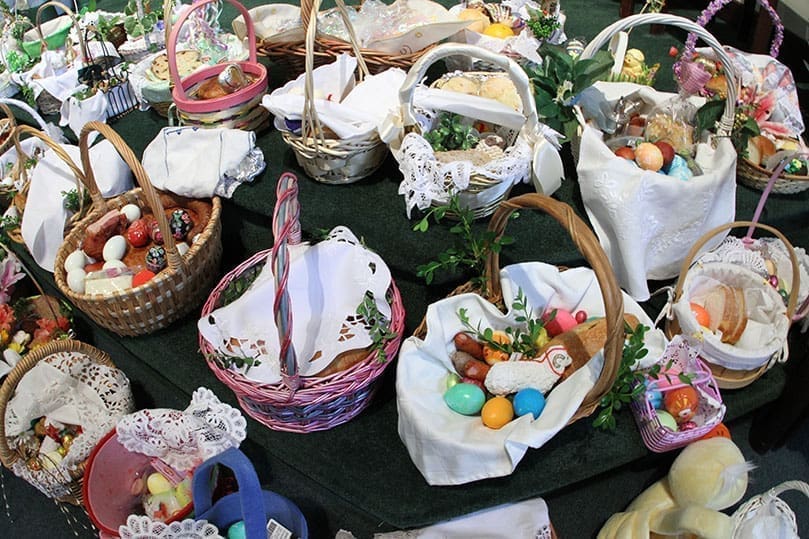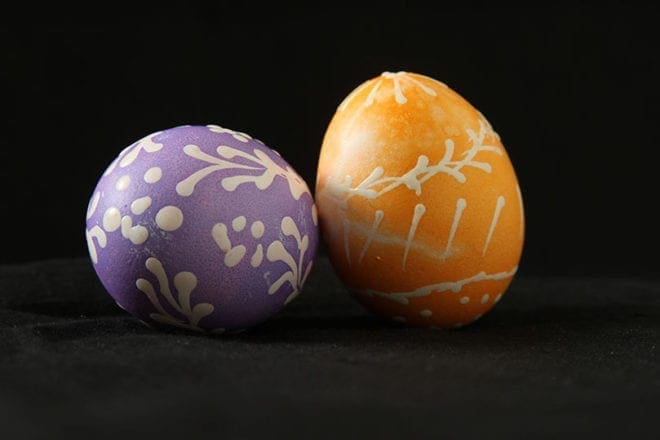 Photo By Michael Alexander
Photo By Michael AlexanderNorcross
Polish Catholics Gather For Blessing Of Baskets
By STEPHEN O'KANE, Staff Writer | Published April 28, 2011
Polish Catholics in the Archdiocese of Atlanta held true to tradition as they participated in “Święconka,” the blessing of Polish Easter baskets, on Holy Saturday at Mary Our Queen Church and St. Marguerite d’Youville Church, Lawrenceville.
Father Piotr Nowacki, chaplain of the Polish Catholic Apostolate for the archdiocese, led the humble services, which were attended by Polish Catholics of all ages. As each family arrived before the blessing, it was usually a young member of the family who approached the altar to place their family’s basket on the altar steps. For the youngsters it may have been something new, and for the older folks, it was a continuation of a tradition in which they participated during their younger days.
Traditions for the Święconka may vary from each village and each family. Some customs have changed or evolved with each generation, but typically the food is brought to the church in a woven basket decorated with a colorful ribbon and greenery, often boxwood, and with a linen cover over the top. Each of the items in the basket holds special meaning and symbolizes one aspect of the Passion and resurrection of Jesus.
Speaking in Polish, Father Nowacki took time to explain the significance of each of the items to the gathered crowd, reminding them of the importance of the tradition. A blend of prayer and song added to the reverence of the event.

The decorative eggs that are part of the traditional Polish Easter basket represent new life and the resurrection of Jesus Christ. Photo By Michael Alexander
After the crowd prayed the Divine Mercy novena together, which included the recitation of the Chaplet of Divine Mercy, Father Nowacki used a small straw brush dipped in holy water to bless the baskets. The priest then processed throughout the church blessing the faithful as well.
Several edible items are found inside each basket, although they aren’t full of chocolate bunnies or other sweets. Instead, there is a mix of meat, dairy and bread products, each chosen with a particular facet of the Easter mystery in mind.
“Babka,” or Easter bread, is found in almost every basket. It is traditionally a round loaf or cake topped with a cross, symbolic of Jesus, the bread of life. Also included in the baskets are “pisanki,” colorful dyed eggs with hand-drawn patterns on them. The eggs represent new life, rebirth and Christ’s resurrection from the tomb. “Chrzan,” or horseradish, represents the bitterness of Christ’s Passion, while butter, usually prepared in the shape of a lamb, represents the goodness of Jesus.
Elizabeth Gurtler-Krawczynska, president of the Polish Apostolate Council for the Archdiocese of Atlanta, said the celebration is a “very important” event in Polish Catholic culture.
“It is not a celebration of the food in the basket, but a celebration of Easter,” she said.
Gurtler-Krawczynska said that the tradition is so strong in Poland that priests perform blessings as often as every half hour on Holy Saturday.
While the baskets are always blessed on Saturday, the family waits until Easter to enjoy the foods inside the basket. The family Easter meal begins with the consumption of the egg, symbolic of Christ’s victory over death.
The tradition has traveled with Polish immigrants as they settled in the United States and has become a staple of the Easter celebration for Polish Catholics on this side of the Atlantic.

Father Piotr Nowacki of the Polish Apostolate at St. Marguerite d’Youville Church, Lawrenceville, blesses the traditional Polish Easter baskets brought by the families in the congregation. Photo By Michael Alexander
The exact origin of the Święconka is unknown, though some of the traditions started in the eighth century.
The intricate process of preparing the pisanki in the Polish tradition can be traced back to the 10th century, though there is some evidence that decorated eggs were prepared even earlier in other Eastern European countries. At one time, only women prepared the pisanki, though everyone from men to women to youngsters participate in the activity today.
The Saturday before Palm Sunday, St. Marguerite d’Youville was buzzing with the Polish Apostolate’s activity. Families from around the area gathered in a room beneath the church to prepare their eggs for Holy Saturday blessing. Children and adults stood side by side as they dipped a utensil in hot wax, drawing patterns on the hard-boiled eggs before dropping them into one of many colors of dye.
Patterns drawn on the eggs are typically geometric and include shapes, lines or waves. Some may include triangles to represent the Holy Trinity or circles to represent eternity. Colors and patterns may vary from culture to culture, but pisanki in the Christian tradition typically all represent new life.
Following the blessing on Holy Saturday, each family collected their basket, often posing for a picture before leaving the church. For many in the Polish community, the Święconka tradition is as important as any of the other events during the Easter Triduum. It is a way to connect to the culture of their homeland and their ancestors, while passing on an important custom to the next generation.
For more information on the Polish Apostolate in the Archdiocese of Atlanta visit www.pcaaa.org.